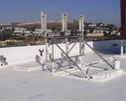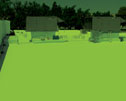One of Milwaukee's most visible and historic landmarks is Milwaukee City Hall, which was designed by architect Henry H. Koch and dedicated in December 1895. With its 353-foot-tall bell tower, which houses a 22,000-pound bell and four clock faces, Milwaukee City Hall was the U.S.' tallest habitable building from 1895-99; it was surpassed by New York's Ivins Syndicate Building, now known as the Park Row Building.
Milwaukee City Hall's German Renaissance Revival design, which can be seen primarily in its curved gable dormers, steep-slope copper roof, circular cupola with balustrade and lantern capping, and terra cotta ornamentation, is a prominent reminder of Milwaukee's large population of German immigrants during the late 1800s.
The City Hall also was the focus of socialism in Milwaukee: In 1910, it was the setting for the largest socialist victory ever registered in a U.S. city when Emil Seidel and a majority Socialist Common Council took office for a short time period.
Milwaukee City Hall was added to the National Register of Historic Places in 1973 and named a National Historic Landmark in 2005.
Wear and tear
As they tend to do, time and weather—particularly during Milwaukee's harsh winter months—took a toll on the historic building. The building underwent $1.8 million of exterior renovations from 1973-74 but continued to deteriorate; scaffolding and netting were placed around the building in 2002 to protect pedestrians from any falling materials.
In 2000, Milwaukee started budget discussions for a major renovation of Milwaukee City Hall, which ultimately would end up being a $70 million project spanning 3 1/2 years. Included in the budgeting process was F.J.A. Christiansen Roofing Co. Inc., Milwaukee, a Tecta America company.
"We do a lot of work for the city, and we had performed repairs on some of Milwaukee City Hall's deteriorated copper elements," says Todd Orvedahl, F.J.A. Christiansen Roofing's senior vice president. "When the city realized how bad the deterioration was based on our inspection reports and photographs, it started the budgeting process and ultimately decided to fully renovate and restore the building's exterior."
After a public bidding process, J.P. Cullen & Sons Inc., Janesville, Wis., was selected as the project's general contractor. F.J.A. Christiansen Roofing was contracted to perform a majority of the roofing work.
"The city wanted a roofing contractor with proper references, experience performing work on historic buildings and one that could perform the extensive copper work," Orvedahl says. "We have a pretty extensive and impressive resume based on past historical renovations around Milwaukee."
In 2005, J.P. Cullen & Sons began restoring the building's façade, which involved renovating worn sandstone, deteriorating brick, terra cotta structures and ornamentation, and almost 2,000 windows.
F.J.A. Christiansen Roofing was asked to replace the elaborate copper cladding on the south clock tower and the smaller north tower; replace copper on the south tower's steep-slope roof; reroof the four low-slope roof areas inside the south tower; and refabricate the towers' decorative copper elements.
Complex installation
F.J.A. Christiansen Roofing began work on Milwaukee City Hall in the summer of 2005 with a long documentation process followed by removal of the towers' copper cladding and elements.
"Because the building is on the National Register of Historic Places, the entire building had to be documented before beginning work," Orvedahl says. "We had to document each roof segment so the new pieces were replicated exactly and put back exactly as they were using updated processes and attachment methods."
After the extensive documentation process was complete, F.J.A. Christiansen Roofing removed the existing copper on the south tower's steep-slope roof area, which rises from the clock dormers with a circular cupola and balustrade and lantern capping the tower and holding a flagpole. The steep-slope roof system originally was slate; copper was installed in 1923 to replace the existing slate. The tower's original terra cotta pinnacles also were replaced with copper in 1928.
"The copper on the steep-slope roof was extremely beat up and thin with pin holes," Orvedahl says.
F.J.A. Christiansen then refabricated almost all the copper elements at its sheet metal shop. Many radius pieces were custom-molded and stamped by Heather & Little Ltd., Markham, Ontario.
"Many of the copper pieces we removed from the towers had to be carefully taken apart so we could make molds and castings of them," Orvedahl says. "Some pieces that needed to be replicated were completely missing. A sculptor was hired to draw and sculpt the missing pieces based on old photos of the building, and then molds were made of the sculpted pieces followed by castings."
F.J.A. Christiansen Roofing began installing new copper cladding and other elements in the summer of 2006. Crews, which ranged from 12 to 40 workers, replaced the existing copper roof on the south tower's steep-slope area, as well as reroofed four low-slope roof areas inside the tower on the 10th, 11th, 12th and 13th floors, which are open to the elements.
"The existing roofs originally were felt and asphalt over a structural terra cotta and concrete deck, and there were many additional layers applied during the years, including some built-up roofing, gravel, etc.," Orvedahl says. "We tore off all the existing layers and installed Siplast SBS polymer-modified bitumen roof systems on the four levels. In some areas, new structural concrete deck was poured."
Crews also performed work on the south tower's lantern area, which proved challenging.
"The lantern area was one of the most complicated parts of the project," says Greg Johnson, F.J.A. Christiansen Roofing's vice president—field operations. "It involved a lot of hand-soldered pieces, including columns, capitals and fancy balustrade railing."
The balustrade railing surrounds one of the low-slope roof areas that runs outside windows in the lantern section.
"The area has a lot of detail work, ornate cornices and decorative stamped pieces," Johnson says.
Crews stripped everything in the lantern area, including the wall cladding and windows, and reclad the windows, which received new glass, with copper.
F.J.A. Christiansen Roofing crews simultaneously performed work on the smaller north tower, replacing copper cladding, substrate and decorative elements.
"We took apart the north tower's lantern area and replicated and reinstalled the pieces," Orvedahl says. "We also repaired the remaining ornate copper tower."
By the end of the project, F.J.A. Christiansen Roofing had installed about 115,000 pounds of copper. According to Johnson, though original drawings and plans facilitated replacement of the building's various architectural elements, installation still proved difficult.
"When you work on a building that's more than 100 years old, nothing is perfectly square or round," he says. "What works on paper doesn't always work in the real world. The project required numerous field modifications."
Orvedahl agrees: "Because every original piece was handmade, you could have four pieces that theoretically were supposed to be the same but were all different. They didn't have the tools and technology we have today."
The most challenging
Complexity of installation was not the only challenge F.J.A. Christiansen Roofing had to contend with during the project. The building's height presented numerous safety issues.
"The building's entire façade was scaffolded and had rails," Orvedahl says. "We performed work off the engineered scaffolding system, to which we were all 100 percent tied-off. In the wind, the building and scaffolding would move a bit. At those heights, it was daunting."
F.J.A. Christiansen Roofing crews also had to contend with Milwaukee's harsh winter weather, which dampened morale.
"We were on-site from the summer of 2006 straight through until December 2008, when the project was slated for completion," Orvedahl says. "The workers struggled yet persevered during the winter—it was cold and windy."
Additionally, getting materials to the various roof areas was a challenge.
"An on-site hoist allowed some materials to be lifted to the roof sections, but some areas were only accessible via interior elevators and stairwells," Johnson says. "Also, the hoist was removed from the job site before our work was done."
A crane was used to lift some of the roof's larger pieces.
"Some of the big, fancy domes and turrets were too big to get into the hoist, so we had them rigged and hoisted into place with a large crane," Orvedahl says.
According to Orvedahl, one of the project's biggest challenges wasn't related to the roofing work but to collaborating with so many people.
"There were a lot of delays from trying to get everybody to agree on things and make decisions," Orvedahl says.
Outstanding workmanship
F.J.A. Christiansen Roofing completed work on Milwaukee City Hall on time in December 2008. Overall completion of the restoration project was celebrated during a ceremony Dec. 18, 2008.
Although the three-year project was grueling, Orvedahl is proud of F.J.A. Christiansen Roofing's work on the historic building.
"It's such a notable, beautiful building; knowing what it was before and what went into it, it's hard to believe it was completed," Orvedahl says.
F.J.A. Christiansen Roofing isn't the only one proud of its work on Milwaukee City Hall: The company received NRCA's Gold Circle Platinum Award—the highest Gold Circle Award given—in the category of Outstanding Workmanship—Steep-slope.
"The project is one of a kind," Orvedahl says. "To know it was done by our people with no accidents is incredible."
Rob McNamara, F.J.A. Christiansen Roofing's president, agrees: "Not only did this project require tremendous skill and dedication by our sheet metal and roofing craftsmen, but it also required great abilities in estimating, negotiating, project managing and, at times, patience by our project leaders."
Ashley St. John is Professional Roofing's associate editor.
Project name: Milwaukee City Hall
Project location: Milwaukee
Project duration: Summer 2005-December 2008
Roof system types: Copper and SBS polymer-modified bitumen
Roofing contractor: F.J.A. Christiansen Roofing Co. Inc., Milwaukee, a Tecta America company
Roofing materials manufacturers: F.J.A. Christiansen Roofing; Heather & Little Ltd., Markham, Ontario; and Siplast, Irving, Texas
Gold Circle Award category: Outstanding Workmanship—Steep-slope



